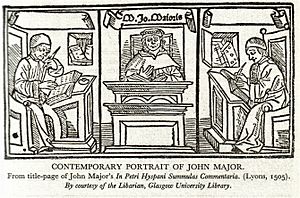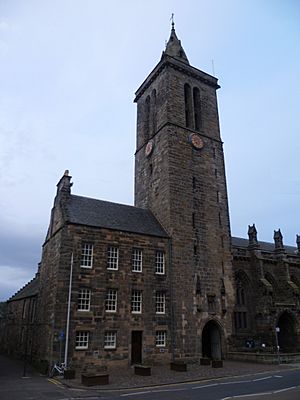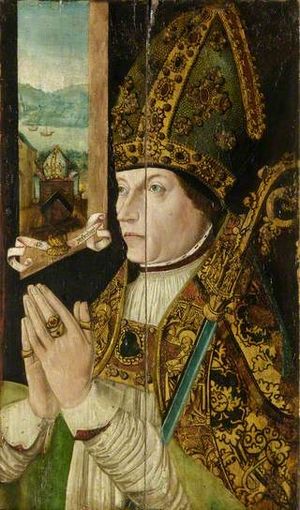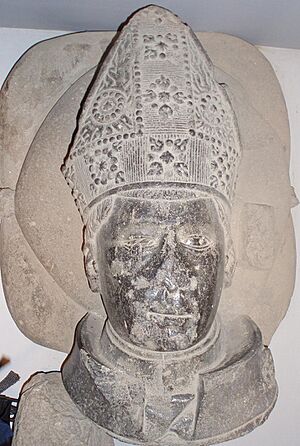Education in Medieval Scotland facts for kids
During the Middle Ages in Scotland (from the 5th to the late 15th century), education was quite different from today. Not many records about schools and learning from this time have survived.
In the early Middle Ages, most people in Scotland learned by listening and speaking, not by reading and writing. There might have been a Gaelic way of teaching, similar to Ireland's, but we don't know much about it.
When Christianity arrived around the 6th century, Latin became important for learning and writing. Monasteries, which were homes for monks, became key places for knowledge. They often had schools.
Later, in the High Middle Ages, new types of schools appeared. These included song schools and grammar schools. Song schools taught music, while grammar schools focused on Latin. Both helped train future priests. These schools grew quickly after the 1380s. By the end of the Middle Ages, most large towns and some smaller ones had grammar schools.
In the countryside, education was probably less common. But there were "petty" or "reading" schools for basic learning. Wealthy families sometimes hired private teachers, and some even had "household schools" for their children. Girls from noble families often learned in nunneries. By the late 1400s, Edinburgh also had schools for girls.
We know of about 100 different schools before the Reformation (a big change in religion). In 1496, a law called the Education Act 1496 was passed. It said that sons of important landowners should go to grammar school to learn "perfect Latin." This helped more people, especially noblemen, learn to read and write. About 60 percent of the nobility could read by the end of this period.
If someone wanted to go to university, they had to travel to England or other European countries. Over 1,000 Scottish students did this between the 1100s and 1410. Famous Scottish thinkers like John Duns Scotus and John Mair came from this system.
This changed when Scotland got its own universities. St John's College, St Andrews was founded in 1418. Then St Salvator's College was added in St. Andrews in 1450. The University of Glasgow opened in 1451, and King's College, Aberdeen in 1495. At first, these universities mainly trained church leaders. But more and more ordinary people started attending, which helped them get important jobs in government and law. These universities offered basic degrees. For more advanced studies, students still went abroad.
Scottish universities mostly taught in Latin, focusing on subjects for priests and lawyers. Towards the end of the 1400s, new ideas from humanism and the teaching of Greek started to appear.
Early Education: Gaelic and Monasteries
In early Medieval Scotland, most people learned by listening and speaking. There were poets, musicians, and historians called filidh (pronounced "fill-ee"). They often worked for kings or lords and passed down their knowledge in Gaelic.
Later, a group called bards took over these roles. They continued to teach in the Highlands and Islands until the 1700s. Bards often trained in special bardic schools. A few of these schools were in Scotland, like the one run by the MacMhuirich family, who were bards to the Lord of the Isles. Much of their work was spoken, not written down.
When Christianity came to Scotland around the 500s, Latin became the language of learning. Monasteries were very important for education. They kept books and often ran schools. These schools trained a small group of educated men who could read and write. This was crucial in a time when most people couldn't. Monasteries had large libraries, showing they were part of the wider European Christian culture.
Medieval Schools
In the High Middle Ages, new types of schools began to appear. These were choir schools and grammar schools. Choir schools taught music, while grammar schools focused on Latin grammar. Both were important for training priests.
The church was reorganized during the reign of King David I (1124–53). This meant that towns like Perth, which were centers for local government, got schools. These schools were usually run by monasteries. Some early grammar schools include the High School of Glasgow (founded in 1124) and the High School of Dundee (founded in 1239). These schools were often connected to large churches or cathedrals.
New religious groups, like the Benedictine and Augustinian monks, also created more chances for education. They needed to train many new monks. Some monasteries had "almonry schools," which were charity schools. They used special funds to help educate poor boys who might become priests. Some monasteries, like Kinloss, Sweetheart Abbey, and Beauly, even taught the sons of wealthy gentlemen.
St Andrews, a major religious center, had both a grammar school and a song school. More than 100 new churches were built between 1450 and the Reformation. These churches needed many singers, called choristers, who were taught music and sometimes grammar. Dominican friars were known for their teaching and often ran grammar schools in towns like Glasgow and Ayr.
The number and size of these schools grew quickly from the late 1300s. By the end of the Middle Ages, grammar schools were in all the main towns and even some smaller ones.
Education was probably harder to find in the countryside. But there were small "petty" or "reading" schools that taught basic skills. Wealthy families, like lords and rich townspeople, also hired private teachers. Sometimes these grew into "household schools" that taught not only the family's children but also neighbors and relatives. This happened at Huntly.
Most of these schools were only for boys. Girls from noble families were taught in nunneries, such as Elcho and Aberdour. By the late 1400s, Edinburgh also had schools for girls. These were sometimes called "sewing schools," which tells us one of their main activities. They probably also taught reading.
We have records of about 100 different schools before the Reformation. Most teachers were churchmen. They often worked as chaplains to earn extra money. The church largely controlled education. However, towards the end of this period, more ordinary people became interested in education.
This sometimes caused disagreements. For example, in Aberdeen, the town appointed a non-churchman as a schoolmaster in 1538, which the church didn't like. Education began to expand beyond just training priests. Lawyers, for instance, became a new profession.
The Education Act 1496 was a big step. It was likely pushed through parliament by William Elphinstone, Bishop of Aberdeen. This law said that all sons of important landowners must go to grammar school to learn "perfect Latin." This led to more people being able to read and write, especially wealthy men. About 60 percent of the nobility could read by the end of the Middle Ages.
Universities

From the late 1000s, universities started appearing across Europe. They were places for learning about subjects like religion, math, law, and medicine. Until the 1400s, Scots who wanted to go to university had to travel abroad. They went to places like Oxford or Cambridge in England, or to universities in Europe like Paris, Cologne, or Vienna. Over 1,000 Scottish students went abroad for their studies between the 1100s and 1410.
One of the most important Scottish thinkers was John Duns Scotus (around 1266–1308). He studied at Oxford, Cambridge, and Paris. He became a very important figure in religious thought. After the Wars of Independence (1296–1357), English universities were mostly closed to Scots. So, more Scots went to universities in Europe. Some Scottish scholars even became teachers there, like John de Rait and Walter Wardlaw in Paris.
This changed when Scotland got its own universities. The first was St John's College, St Andrews, founded in 1418. Henry Wardlaw, the bishop of St. Andrews, asked the Pope for permission. He argued that Scottish students were being treated unfairly in other universities. St Salvator's College was added to St. Andrews in 1450.
Other major church leaders followed this example. The University of Glasgow was founded in 1451, and King's College, Aberdeen in 1495. Both were also approved by the Pope. St Leonard's College was added in St. Andrews in 1511.
St. Andrews was designed like the University of Paris. Glasgow and Aberdeen also took ideas from Paris. At first, these universities mainly trained people for the church. But more and more ordinary people started attending. This helped them get important jobs in government and law, which used to be only for churchmen.
These Scottish universities offered basic degrees. If students wanted more advanced degrees, they still had to go to universities in other countries. So, Scottish scholars continued to travel to Europe and later returned to English universities when they reopened to Scots.
By the 1400s, universities in Italy started to be influenced by new ideas called humanism. This meant studying old Greek and Roman writers and questioning old ways of thinking. However, Scottish universities mostly stuck to a Latin curriculum. They focused on subjects for church leaders and lawyers. They didn't teach Greek, which was key to humanism. They also relied heavily on the ideas of Aristotle.
Towards the end of the 1400s, humanist ideas slowly started to appear in Scotland. Archibald Whitelaw, a teacher at St. Andrews, became a tutor to King James III. In 1497, Hector Boece, a humanist who studied in Paris, became the first head of the new University of Aberdeen. In 1518, John Mair returned to Scotland to lead the University of Glasgow. His students included famous figures like John Knox and George Buchanan. These connections helped Scotland join the wider European world of learning and brought new humanist ideas into Scottish thinking.




